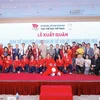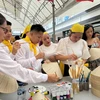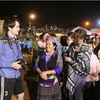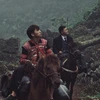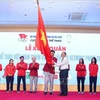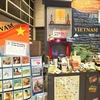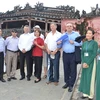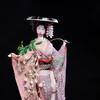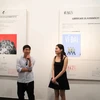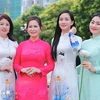 The road to Chien hamlet is dangerous but majestic with one side leaning against a cliff and the other embracing the winding fields. Surrounded by high mountains, Chien hamlet in Nam Son commune and Buoi Cai hamlet in Phu Cuong commune are popular community-based tourist attractions in Tan Lac district, hailed as "living museums" of the Muong ethnic people’s cultural space. Every object inside the traditional stilt houses of the locals has its own story with a strong attachment to the traditions of the family and village. These objects can include a set of Muong gongs hanging on the wall, traditional costumes for traditional festivals, and bundles of bamboo poles at the foot of the stilt house, used for jubilant bamboo pole dances. (Photo: VietnamPlus)
The road to Chien hamlet is dangerous but majestic with one side leaning against a cliff and the other embracing the winding fields. Surrounded by high mountains, Chien hamlet in Nam Son commune and Buoi Cai hamlet in Phu Cuong commune are popular community-based tourist attractions in Tan Lac district, hailed as "living museums" of the Muong ethnic people’s cultural space. Every object inside the traditional stilt houses of the locals has its own story with a strong attachment to the traditions of the family and village. These objects can include a set of Muong gongs hanging on the wall, traditional costumes for traditional festivals, and bundles of bamboo poles at the foot of the stilt house, used for jubilant bamboo pole dances. (Photo: VietnamPlus)  Most of the villages of the Muong people in Tan Lac are located in the valley. In the low-lying areas, local people cultivate rice and on the hills they grow fruit trees. Visitors to Tan Lac are welcomed by the friendliness and hospitality of locals, willing to open their doors to their guests and join tourists to pick bamboo shoots in the forest and go catching fish in the streams for a delicious meal together like a family. The Muong have a population of around 1 million who live mainly in northern provinces like Hoa Binh and Thanh Hoa. The Muong culture is related to Hoa Binh culture dating back more than 10,000 years. (Photo: VietnamPlus)
Most of the villages of the Muong people in Tan Lac are located in the valley. In the low-lying areas, local people cultivate rice and on the hills they grow fruit trees. Visitors to Tan Lac are welcomed by the friendliness and hospitality of locals, willing to open their doors to their guests and join tourists to pick bamboo shoots in the forest and go catching fish in the streams for a delicious meal together like a family. The Muong have a population of around 1 million who live mainly in northern provinces like Hoa Binh and Thanh Hoa. The Muong culture is related to Hoa Binh culture dating back more than 10,000 years. (Photo: VietnamPlus)  Chien hamlet is situated 900 metre above the sea level. It is described as the living museum of the Muong ethnics’ culture. The Muong share ethnic roots with the Vietnamese people and their language is classified in the Vietnamese – Muong language branch. The Muong ethnic people live in mountainous areas which have abundant land for growing wet rice. In a Muong hamlet, stilt houses shelter in the shade of big trees, huddle against the mountain, and look out on vast rice fields. A Muong house is designed to maximize convenient use and air ventilation to counter the warm, humid mountain climate. (Photo: VietnamPlus)
Chien hamlet is situated 900 metre above the sea level. It is described as the living museum of the Muong ethnics’ culture. The Muong share ethnic roots with the Vietnamese people and their language is classified in the Vietnamese – Muong language branch. The Muong ethnic people live in mountainous areas which have abundant land for growing wet rice. In a Muong hamlet, stilt houses shelter in the shade of big trees, huddle against the mountain, and look out on vast rice fields. A Muong house is designed to maximize convenient use and air ventilation to counter the warm, humid mountain climate. (Photo: VietnamPlus)  Boasting rich valleys with fertile rice fields and fruit-laden gardens, Tan Lac district in the northern province of Hoa Binh is an ideal place for those interested in exploring the indigenous culture of the Muong ethnic group while enjoying a tranquil and peaceful atmosphere away from the busy city. Chien hamlet in Nam Son commune is billed as a living museum of the Muong ethnic people’s cultural space. Every object inside the traditional stilt houses of the locals has its own story with a strong attachment to the traditions of the family and village. These objects can include a set of Muong gongs hanging on the wall and traditional costumes for traditional festivals. (Photo: VietnamPlus)
Boasting rich valleys with fertile rice fields and fruit-laden gardens, Tan Lac district in the northern province of Hoa Binh is an ideal place for those interested in exploring the indigenous culture of the Muong ethnic group while enjoying a tranquil and peaceful atmosphere away from the busy city. Chien hamlet in Nam Son commune is billed as a living museum of the Muong ethnic people’s cultural space. Every object inside the traditional stilt houses of the locals has its own story with a strong attachment to the traditions of the family and village. These objects can include a set of Muong gongs hanging on the wall and traditional costumes for traditional festivals. (Photo: VietnamPlus)  According to archives, the Muong ethnic people have quite a lot in common regarding ethnology and culture with their Kinh brethren. The Kinh people make up the majority of the country’s population. The Muong people typically inhabit mountainous areas in such provinces as Hoa Binh and Thanh Hoa. Visitors to the houses are also introduced to the tangible and intangible cultural heritage of the Muong ethnic group, such as Mo Muong, a job and also a performance practiced at funerals, religious festivals, and life cycle rituals by the Muong ethnic community, and Chieng Muong, the gong culture of the Muong people. (Photo: VietnamPlus)
According to archives, the Muong ethnic people have quite a lot in common regarding ethnology and culture with their Kinh brethren. The Kinh people make up the majority of the country’s population. The Muong people typically inhabit mountainous areas in such provinces as Hoa Binh and Thanh Hoa. Visitors to the houses are also introduced to the tangible and intangible cultural heritage of the Muong ethnic group, such as Mo Muong, a job and also a performance practiced at funerals, religious festivals, and life cycle rituals by the Muong ethnic community, and Chieng Muong, the gong culture of the Muong people. (Photo: VietnamPlus)  Mo Muong is a unique cultural heritage of the Muong ethnic group in the northwestern province of Hoa Binh. It is a job and also a performance practiced at funerals, religious festivals, and life cycle rituals by the Muong ethnic group. The art consists of Mo prayers and performances, by Mo practitioners, or Mo artisans. Through generations, Mo prayers have been passed down verbally in the community. When they’re collected, translated, and published in books, however, they begin to exist separately from people. These days, most Mo prayers are called Mo Muong. They are a collection of verses recited at traditional Muong funerals. They are divided into "cat Mo” and "roong Mo”, similar to chapters in literature. (Photo: VietnamPlus)
Mo Muong is a unique cultural heritage of the Muong ethnic group in the northwestern province of Hoa Binh. It is a job and also a performance practiced at funerals, religious festivals, and life cycle rituals by the Muong ethnic group. The art consists of Mo prayers and performances, by Mo practitioners, or Mo artisans. Through generations, Mo prayers have been passed down verbally in the community. When they’re collected, translated, and published in books, however, they begin to exist separately from people. These days, most Mo prayers are called Mo Muong. They are a collection of verses recited at traditional Muong funerals. They are divided into "cat Mo” and "roong Mo”, similar to chapters in literature. (Photo: VietnamPlus)  Each Muong community has its own version of Mo, but they are all fairly similar. The existence of various versions of Mo has helped expand the heritage and spiritual life of the Muong people. Mo Muong has a long life, spanning centuries, as it has always helped to nurture the characteristics and the souls of the Muong people. It is the essence of labour, production, cultural behaviour and the philosophy of the Muong people, reflecting their love of life and home villages. According to folk cultural specialists, Mo Muong is classified into three categories: Mo Nghi Le (Ceremonial Mo), Mo Ke Chuyen (Story Telling Mo) and Mo Nhom, in which “thay mo” or mo masters play an important role in forming the essence of the unique culture. (Photo: VietnamPlus)
Each Muong community has its own version of Mo, but they are all fairly similar. The existence of various versions of Mo has helped expand the heritage and spiritual life of the Muong people. Mo Muong has a long life, spanning centuries, as it has always helped to nurture the characteristics and the souls of the Muong people. It is the essence of labour, production, cultural behaviour and the philosophy of the Muong people, reflecting their love of life and home villages. According to folk cultural specialists, Mo Muong is classified into three categories: Mo Nghi Le (Ceremonial Mo), Mo Ke Chuyen (Story Telling Mo) and Mo Nhom, in which “thay mo” or mo masters play an important role in forming the essence of the unique culture. (Photo: VietnamPlus)  The Muong’s costume is special. The Muong women wear a long, black dress and a white or brown shirt with a line of buttons in the front and long sleeves. They wind a white or indigo headscarf around their head. The highlights of the Muong costume are embroidery on the dress hem and belt. It requires skill and artistic talent to design the patterns and harmonize the colors of the costume. Meanwhile, men often wear a round-neck shirt which opens in the front and has two pockets. Their pants have large trouser legs. On special occasions, the Muong men wear a purple or yellow silk shirt inside a long, white ceremonial robe. (Photo: VietnamPlus)
The Muong’s costume is special. The Muong women wear a long, black dress and a white or brown shirt with a line of buttons in the front and long sleeves. They wind a white or indigo headscarf around their head. The highlights of the Muong costume are embroidery on the dress hem and belt. It requires skill and artistic talent to design the patterns and harmonize the colors of the costume. Meanwhile, men often wear a round-neck shirt which opens in the front and has two pockets. Their pants have large trouser legs. On special occasions, the Muong men wear a purple or yellow silk shirt inside a long, white ceremonial robe. (Photo: VietnamPlus)  Muong women mostly make their clothes themselves, from weaving and dyeing the material to embroidering. They are very skillful at dyeing, making glossy fabric with fast colors. They can even make floral patterns in the dyeing process. These beautiful and elegant dresses are worn along with intricately carved silver jewelry including rings, earrings, brooches, bracelets and necklaces. The bracelet is a very popular piece of jewelry among the Muong. Flat or round, they are usually carved with attractive patterns. Bead necklaces also feature gems in the shape of lozenges or hexagons. Another adornment worn by Muong women is the day oc tro, a kind of silver container for keeping tobacco or aloe-wood that is suspended from the waistband by a cord. (Photo: VietnamPlus)
Muong women mostly make their clothes themselves, from weaving and dyeing the material to embroidering. They are very skillful at dyeing, making glossy fabric with fast colors. They can even make floral patterns in the dyeing process. These beautiful and elegant dresses are worn along with intricately carved silver jewelry including rings, earrings, brooches, bracelets and necklaces. The bracelet is a very popular piece of jewelry among the Muong. Flat or round, they are usually carved with attractive patterns. Bead necklaces also feature gems in the shape of lozenges or hexagons. Another adornment worn by Muong women is the day oc tro, a kind of silver container for keeping tobacco or aloe-wood that is suspended from the waistband by a cord. (Photo: VietnamPlus)  The Muong ethnics hold a treasure of traditional art and culture, including mo Muong, ancient story, and folk songs. Of them, Mo Muong, the Muong folk encyclopedia that has been orally handed down through many generations, contains educational values for the community. However, this intangible cultural heritage is in danger of going extinct due to the impact of industrialisation and globalisation. In Hoa Binh, the number of “thay mo” in villages has decreased. Statistics of the provincial Department of Culture, Sports and Tourism showed that the province has 190 artisans, many of them very old. Since 2010, Hoa Binh has put forth specific solutions to preserve the culture. (Photo: VietnamPlus)
The Muong ethnics hold a treasure of traditional art and culture, including mo Muong, ancient story, and folk songs. Of them, Mo Muong, the Muong folk encyclopedia that has been orally handed down through many generations, contains educational values for the community. However, this intangible cultural heritage is in danger of going extinct due to the impact of industrialisation and globalisation. In Hoa Binh, the number of “thay mo” in villages has decreased. Statistics of the provincial Department of Culture, Sports and Tourism showed that the province has 190 artisans, many of them very old. Since 2010, Hoa Binh has put forth specific solutions to preserve the culture. (Photo: VietnamPlus) VNA




